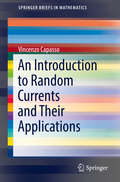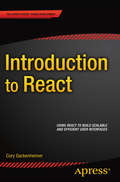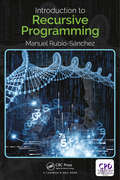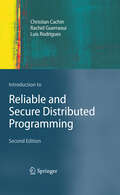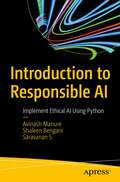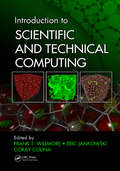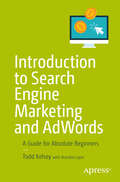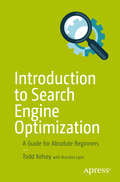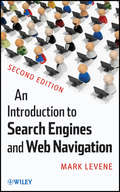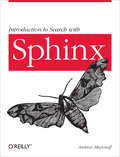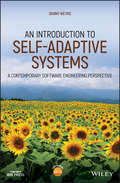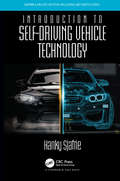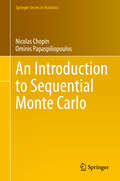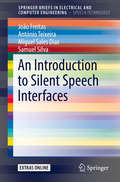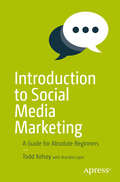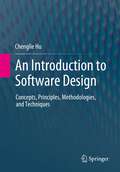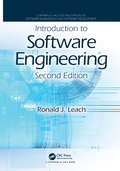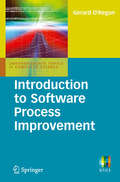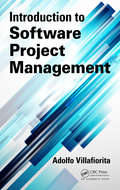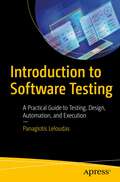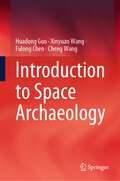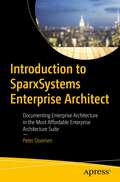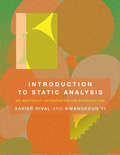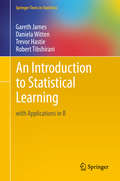- Table View
- List View
An Introduction to Random Currents and Their Applications (SpringerBriefs in Mathematics)
by Vincenzo CapassoThis book introduces random currents by presenting underlying mathematical methods necessary for applications. The theory of currents is an advanced topic in geometric measure theory that extends distribution to linear functionals within the space of differential forms of any order. Methods to extend random distributions to random currents are introduced and analyzed in this book. Beginning with an overview of mathematical aspects of the theory of currents, this book moves on to examine applications in medicine, material science, and image analysis. Applied researchers will find the practical modern mathematical methods along with the detailed appendix useful to stimulate new applications and research.
Introduction to React
by Cory GackenheimerIntroduction to React teaches you React, the JavaScript framework created by developers at Facebook, to solve the problem of building complex user interfaces in a consistent and maintainable way. React. js shrugs away common front-end conventions in an effort to make things more efficient - use Introduction to React to learn about this framework and more today. Get to know the React API and it's specific JavaScript extension, JSX, which makes authoring React components easier and maintainable. You will also learn how to test your React applications and about the tools you can use while building. Once you understand these core concepts, you can build applications with React. This will help you cement the ideas and fundamentals of React and prepare you to utilize React in your own use case. What you'll learn How to use React to maintain complex user interfaces in an efficient way How to integrate existing user interfaces and move forward with React How to manage application architecture using Flux How to easily utilize JSX, React's JavaScript extension Who this book is for Introduction to React is for a web developer who is comfortable writing JavaScript and CSS. You will apply JavaScript to build web pages that utilize the paradigm shifting React framework. Introduction to React will provide you with the tools to create maintainable complex user interfaces. Table of Contents Chapter 1: What is React? Chapter 2: The Core of React Chapter 3: JSX Fundamentals Chapter 4: Building A React Web Application Chapter 5: Introducing Flux: An Application Architecture for React Chapter 6: Using Flux to Structure a React Application
Introduction to Recursive Programming
by Manuel Rubio-SanchezRecursion is one of the most fundamental concepts in computer science and a key programming technique that allows computations to be carried out repeatedly. Despite the importance of recursion for algorithm design, most programming books do not cover the topic in detail, despite the fact that numerous computer programming professors and researchers in the field of computer science education agree that recursion is difficult for novice students. Introduction to Recursive Programming provides a detailed and comprehensive introduction to recursion. This text will serve as a useful guide for anyone who wants to learn how to think and program recursively, by analyzing a wide variety of computational problems of diverse difficulty. It contains specific chapters on the most common types of recursion (linear, tail, and multiple), as well as on algorithm design paradigms in which recursion is prevalent (divide and conquer, and backtracking). Therefore, it can be used in introductory programming courses, and in more advanced classes on algorithm design. The book also covers lower-level topics related to iteration and program execution, and includes a rich chapter on the theoretical analysis of the computational cost of recursive programs, offering readers the possibility to learn some basic mathematics along the way. It also incorporates several elements aimed at helping students master the material. First, it contains a larger collection of simple problems in order to provide a solid foundation of the core concepts, before diving into more complex material. In addition, one of the book's main assets is the use of a step-by-step methodology, together with specially designed diagrams, for guiding and illustrating the process of developing recursive algorithms. Furthermore, the book covers combinatorial problems and mutual recursion. These topics can broaden students' understanding of recursion by forcing them to apply the learned concepts differently, or in a more sophisticated manner. The code examples have been written in Python 3, but should be straightforward to understand for students with experience in other programming languages. Finally, worked out solutions to over 120 end-of-chapter exercises are available for instructors.
Introduction to Reliable and Secure Distributed Programming
by Christian Cachin Luís Rodrigues Rachid GuerraouiThe scope of this second edition of the introduction to fundamental distributed programming abstractions has been extended to cover 'Byzantine fault tolerance'. It includes algorithms to implement these abstractions in vulnerable distributed systems.
Introduction to Responsible AI: Implement Ethical AI Using Python
by Avinash Manure Shaleen Bengani Saravanan SLearn and implement responsible AI models using Python. This book will teach you how to balance ethical challenges with opportunities in artificial intelligence. The book starts with an introduction to the fundamentals of AI, with special emphasis given to the key principles of responsible AI. The authors then walk you through the critical issues of detecting and mitigating bias, making AI decisions understandable, preserving privacy, ensuring security, and designing robust models. Along the way, you’ll gain an overview of tools, techniques, and code examples to implement the key principles you learn in real-world scenarios. The book concludes with a chapter devoted to fostering a deeper understanding of responsible AI’s profound implications for the future. Each chapter offers a hands-on approach, enriched with practical insights and code snippets, enabling you to translate ethical considerations into actionable solutions. What You Will Learn Understand the principles of responsible AI and their importance in today's digital worldMaster techniques to detect and mitigate bias in AIExplore methods and tools for achieving transparency and explainabilityDiscover best practices for privacy preservation and security in AIGain insights into designing robust and reliable AI models Who This Book Is For AI practitioners, data scientists, machine learning engineers, researchers, policymakers, and students interested in the ethical aspects of AI
Introduction to Scientific and Technical Computing
by FRANK T. WILLMORE, ERIC JANKOWSKI AND CORAY COLINACreated to help scientists and engineers write computer code, this practical book addresses the important tools and techniques that are necessary for scientific computing, but which are not yet commonplace in science and engineering curricula. This book contains chapters summarizing the most important topics that computational researchers need to know about. It leverages the viewpoints of passionate experts involved with scientific computing courses around the globe and aims to be a starting point for new computational scientists and a reference for the experienced. Each contributed chapter focuses on a specific tool or skill, providing the content needed to provide a working knowledge of the topic in about one day. While many individual books on specific computing topics exist, none is explicitly focused on getting technical professionals and students up and running immediately across a variety of computational areas.
Introduction to Search Engine Marketing and AdWords: A Guide For Absolute Beginners
by Todd KelseyUse Google's AdWords to create your ads. Each chapter goes beyond the tool itself, discussing helpful resources and important issues to keep in mind. If you are completely new to search engine marketing and AdWords and you want to learn the basics, this guide will introduce you to the content quickly. Introduction to Search Engine Marketing and AdWords is not in-depth, comprehensive, or trying to cover every tool or platform--an impossible task! But it is an easy-to-understand introduction to the most important tools and skills in search engine marketing. What You'll Learn Take a behind-the-scenes tour of AdWords, including how to create an account Create and launch a campaign as well as ads, including keyword tools Monitor a campaign, including time frame, clicks and CTR, and reporting Implement various campaign strategies, including support email and dealing with errors Use Ad extensions as well as site links Who This Book Is For Those who need to get up to speed on search engine marketing tools and techniques for business or personal use. This book is also suitable as a student reference.
Introduction to Search Engine Optimization: A Guide For Absolute Beginners
by Todd KelseyDon't be intimidated by all the search engine optimization (SEO) tools out there. You will start out learning about keywords and the importance of quality content and then walk through incremental steps as you try out the tools and master the tips and strategies. If you are completely new to search engine optimization and you want to learn the basics, this guide will introduce you to the content quickly. Introduction to Search Engine Optimization is a detailed guide to the most important tools and skills needed to accurately and effectively utilize search engine optimization. This book covers SEO basics, keyword research, SEO ranking and analytics, Google Analytics, and more. It also includes an overview of how to pursue SEO-related certifications. What You'll Learn Create a content platform, including blogs and YouTube channels Use keywords to maximize findability and increase search volume Check your SEO rank and other analytics Hunt for duplicate content Set up Google Analytics, including Blogger Utilize Indexing and Webmaster tools/search console Who This Book Is For Those who need to get up to speed on search engine optimization tools and techniques for business or personal use. This book is also suitable as a student reference.
An Introduction to Search Engines and Web Navigation
by Mark LeveneThis book is a second edition, updated and expanded to explain the technologies that help us find information on the web. Search engines and web navigation tools have become ubiquitous in our day to day use of the web as an information source, a tool for commercial transactions and a social computing tool. Moreover, through the mobile web we have access to the web's services when we are on the move. This book demystifies the tools that we use when interacting with the web, and gives the reader a detailed overview of where we are and where we are going in terms of search engine and web navigation technologies.
Introduction to Search with Sphinx
by Andrew AksyonoffThis concise introduction to Sphinx shows you how to use this free software to index an enormous number of documents and provide fast results to both simple and complex searches. Written by the creator of Sphinx, this authoritative book is short and to the point. Understand the particular way Sphinx conducts searches Install and configure Sphinx, and run a few basic tests Issue basic queries to Sphinx at the application level Learn the syntax of search text and the effects of various search options Get strategies for dealing with large data sets, such as multi-index searching Apply relevance and ranking guidelines for presenting best results to the user
An Introduction to Self-adaptive Systems: A Contemporary Software Engineering Perspective (Wiley - IEEE)
by Danny WeynsA concise and practical introduction to the foundations and engineering principles of self-adaptation Though it has recently gained significant momentum, the topic of self-adaptation remains largely under-addressed in academic and technical literature. This book changes that. Using a systematic and holistic approach, An Introduction to Self-adaptive Systems: A Contemporary Software Engineering Perspective provides readers with an accessible set of basic principles, engineering foundations, and applications of self-adaptation in software-intensive systems. It places self-adaptation in the context of techniques like uncertainty management, feedback control, online reasoning, and machine learning while acknowledging the growing consensus in the software engineering community that self-adaptation will be a crucial enabling feature in tackling the challenges of new, emerging, and future systems. The author combines cutting-edge technical research with basic principles and real-world insights to create a practical and strategically effective guide to self-adaptation. He includes features such as: An analysis of the foundational engineering principles and applications of self-adaptation in different domains, including the Internet-of-Things, cloud computing, and cyber-physical systems End-of-chapter exercises at four different levels of complexity and difficulty An accompanying author-hosted website with slides, selected exercises and solutions, models, and code Perfect for researchers, students, teachers, industry leaders, and practitioners in fields that directly or peripherally involve software engineering, as well as those in academia involved in a class on self-adaptivity, this book belongs on the shelves of anyone with an interest in the future of software and its engineering.
Introduction to Self-Driving Vehicle Technology (Chapman & Hall/CRC Artificial Intelligence and Robotics Series)
by Hanky SjafrieThis book aims to teach the core concepts that make Self-driving vehicles (SDVs) possible. It is aimed at people who want to get their teeth into self-driving vehicle technology, by providing genuine technical insights where other books just skim the surface. The book tackles everything from sensors and perception to functional safety and cybersecurity. It also passes on some practical know-how and discusses concrete SDV applications, along with a discussion of where this technology is heading. It will serve as a good starting point for software developers or professional engineers who are eager to pursue a career in this exciting field and want to learn more about the basics of SDV algorithms. Likewise, academic researchers, technology enthusiasts, and journalists will also find the book useful. Key Features: Offers a comprehensive technological walk-through of what really matters in SDV development: from hardware, software, to functional safety and cybersecurity Written by an active practitioner with extensive experience in series development and research in the fields of Advanced Driver Assistance Systems (ADAS) and Autonomous Driving Covers theoretical fundamentals of state-of-the-art SLAM, multi-sensor data fusion, and other SDV algorithms. Includes practical information and hands-on material with Robot Operating System (ROS) and Open Source Car Control (OSCC). Provides an overview of the strategies, trends, and applications which companies are pursuing in this field at present as well as other technical insights from the industry.
An Introduction to Sequential Monte Carlo (Springer Series in Statistics)
by Nicolas Chopin Omiros PapaspiliopoulosThis book provides a general introduction to Sequential Monte Carlo (SMC) methods, also known as particle filters. These methods have become a staple for the sequential analysis of data in such diverse fields as signal processing, epidemiology, machine learning, population ecology, quantitative finance, and robotics.The coverage is comprehensive, ranging from the underlying theory to computational implementation, methodology, and diverse applications in various areas of science. This is achieved by describing SMC algorithms as particular cases of a general framework, which involves concepts such as Feynman-Kac distributions, and tools such as importance sampling and resampling. This general framework is used consistently throughout the book.Extensive coverage is provided on sequential learning (filtering, smoothing) of state-space (hidden Markov) models, as this remains an important application of SMC methods. More recent applications, such as parameter estimation of these models (through e.g. particle Markov chain Monte Carlo techniques) and the simulation of challenging probability distributions (in e.g. Bayesian inference or rare-event problems), are also discussed.The book may be used either as a graduate text on Sequential Monte Carlo methods and state-space modeling, or as a general reference work on the area. Each chapter includes a set of exercises for self-study, a comprehensive bibliography, and a “Python corner,” which discusses the practical implementation of the methods covered. In addition, the book comes with an open source Python library, which implements all the algorithms described in the book, and contains all the programs that were used to perform the numerical experiments.
An Introduction to Silent Speech Interfaces (SpringerBriefs in Speech Technology)
by João Freitas António Teixeira Miguel Sales Dias Samuel SilvaThis book provides a broad and comprehensive overview of the existing technical approaches in the area of silent speech interfaces (SSI), both in theory and in application. Each technique is described in the context of the human speech production process, allowing the reader to clearly understand the principles behind SSI in general and across different methods. Additionally, the book explores the combined use of different data sources, collected from various sensors, in order to tackle the limitations of simpler SSI approaches, addressing current challenges of this field. The book also provides information about existing SSI applications, resources and a simple tutorial on how to build an SSI.
Introduction to Social Media Marketing: A Guide For Absolute Beginners
by Todd KelseyEasily understand the most important tools and skills in social media marketing. You'll be exposed to Facebook pages and ads, work with Twitter and LinkedIn, save time with Hootsuite, and learn social media monitoring. If you are completely new to social media marketing and you want to learn the basics, this guide will introduce you to the content quickly. Introduction to Social Media Marketing has a particular focus on ROI (return on investment), to help you think critically about the value social media could bring a business or organization. You'll explore the question of whether or not it's worth it to invest time and money in each social media channel. What You'll Learn Understand basic functions for most social media tools, including how to get up and running See the benefits of social media tools and which one you should use for specific purposes Calculate the real ROI expected from using specific tools Utilize social media monitoring and analytics Who This Book Is For Those who need to get up to speed on a broad range of social media tools and techniques for business or personal use. This book is also suitable as a student reference.
An Introduction to Software Design: Concepts, Principles, Methodologies, and Techniques
by Chenglie HuThis textbook provides a balanced coverage on software design, including design principles, methodologies, and techniques in contexts of designing modules of small and larger sizes with a multi-paradigm viewpoint emphasizing design trade-off. Commonly used design diagrams and patterns are also covered in terms of the design ideas behind and their effective use. The book also explores what (software) design thinking is, the role it plays in a design process, and ways to promote it. Despite object orientation being still the center of attention, there is a strong promotion throughout the book that software design should consider all appropriate design paradigms and methodologies.The book is organized in 10 chapters. Chapter 1 is dedicated to an exploration of what software design may be and entail. Next, chapters 2 and 3 are designed to help readers better understand object orientation, and the essentials of object-oriented design. Chapter 4 is then dedicated to the design of methods, while chapters 5, 6, and 8 respectively include topics about the design of objects, modeling with the Unified Modeling Language, and the use of design patterns. Larger software elements are often directly responsible for the formation of software architecture, thus chapter 7 covers four kinds of larger software elements: libraries, components, frameworks, and microservices, and their architectural implications. Chapter 9 finally brings the presentation of software design to an end with a coverage on software architecture focusing on software architectural views. Case studies are important in learning how to design software, hence chapter 10 then gathers some small design case studies that can be used in earlier chapters as appropriate. These case studies can be extended in different ways to provide additional design opportunities.This textbook book is intended for a junior level undergraduate course on software design, yet the depth of the book makes it also appropriate for a design course at beginning graduate level. Professionals may also find the book useful in their professional development.
Introduction to Software Engineering (Chapman & Hall/CRC Innovations in Software Engineering and Software Development Series)
by Ronald J. LeachPractical Guidance on the Efficient Development of High-Quality Software Introduction to Software Engineering, Second Edition equips students with the fundamentals to prepare them for satisfying careers as software engineers regardless of future changes in the field, even if the changes are unpredictable or disruptive in nature. Retaining the same organization as its predecessor, this second edition adds considerable material on open source and agile development models. The text helps students understand software development techniques and processes at a reasonably sophisticated level. Students acquire practical experience through team software projects. Throughout much of the book, a relatively large project is used to teach about the requirements, design, and coding of software. In addition, a continuing case study of an agile software development project offers a complete picture of how a successful agile project can work. The book covers each major phase of the software development life cycle, from developing software requirements to software maintenance. It also discusses project management and explains how to read software engineering literature. Three appendices describe software patents, command-line arguments, and flowcharts.
Introduction to Software Process Improvement
by Gerard O'ReganThis textbook is a systematic guide to the steps in setting up a Capability Maturity Model Integration (CMMI) improvement initiative. Readers will learn the project management practices necessary to deliver high-quality software solutions to the customer on time and on budget. The text also highlights how software process improvement can achieve specific business goals to provide a tangible return on investment. Topics and features: supplies review questions, summaries and key topics for each chapter, as well as a glossary of acronyms; describes the CMMI model thoroughly, detailing the five maturity levels; provides a broad overview of software engineering; reviews the activities and teams required to set up a CMMI improvement initiative; examines in detail the implementation of CMMI in a typical organization at each of the maturity levels; investigates the various tools that support organizations in improving their software engineering maturity; discusses the SCAMPI appraisal methodology.
Introduction to Software Project Management
by Adolfo VillafioritaAlthough software development is one of the most complex activities carried out by man, sound development processes and proper project management can help ensure your software projects are delivered on time and under budget. Providing the know-how to manage software projects effectively, Introduction to Software Project Management supplies an acces
Introduction to Software Testing: A Practical Guide to Testing, Design, Automation, and Execution
by Panagiotis LeloudasGet started and hit the ground running in the world of software testing. This simple and practical guide teaches you the fundamentals of software testing, with no prior experience required. You will start by learning functional and non-functional software testing. Then you will gain an understanding of the primary responsibilities of a tester in the Software Development Life Cycle and how to plan and execute testing activities. You will also learn how testing applies to an agile environment, what challenges you might face in your day-to-day life as a tester, and how to overcome them. You will learn the most commonly used test design techniques, with ample examples and exercises to practice yourself. By the end of this book, you will understand the software testing ecosystem, from its types, techniques, and tools, to test planning, execution, and reporting. What You Will Learn Master the fundamentals of Software TestingGain an understanding of different software testing typesPlan and execute testing activitiesApply test design techniques to concrete examples Who This Book Is For Software testers, developers, project managers, and other stakeholders involved in software testing.
Introduction to Software Testing
by Jeff Offutt Paul AmmannExtensively class-tested, this textbook takes an innovative approach to software testing: it defines testing as the process of applying a few well-defined, general-purpose test criteria to a structure or model of the software. It incorporates the latest innovations in testing, including techniques to test modern types of software such as OO, web applications, and embedded software. The book contains numerous examples throughout. An instructors solution manual, PowerPoint slides, sample syllabi, additional examples and updates, testing tools for students, and example software programs in Java are available on an extensive website.
Introduction to Space Archaeology
by Huadong Guo Xinyuan Wang Fulong Chen Cheng WangThis book presents the basic principles and the latest advances in space archaeology. Following general reviews of the state of the art of Earth observation technologies and archaeology, the book introduces the principles and methods of space archaeology, remote sensing methods for archaeological survey, and integrated archaeological survey methods including geophysics, virtual reality, web technologies, global positioning systems (GPS), geographical information systems (GIS), and big data. The book then presents two chapters on case studies of word heritage sites in Asia, Europe, Africa, and Americas, including three major world heritage sites in China: The Great Wall, Grand Canal, and Silk Road. The last chapter of the book discusses the future of space archaeology. This book has an interdisciplinary appeal and scholars with an interest in cultural heritage and remote sensing technologies for Earth value its contribution.
Introduction to SparxSystems Enterprise Architect: Documenting Enterprise Architecture in the Most Affordable Enterprise Architecture Suite
by Peter DoomenSparxSystems Enterprise Architect (EA) is a logical choice for many companies and organizations: it combines a broad feature set with an affordable price. However, the robust range of features makes starting to use this fantastic tool a bit intimidating. Enter Michael, a fictional consultant and experienced enterprise architect featured throughout the book to show you how to populate a model with elements and connectors, and how to create diagrams that speak to the audience: management, project managers, internal audit, business stakeholders and IT representatives. As the book progresses Michael's duties continue with more advanced topics including the use of workflow tools such as Kanban boards. You'll even see how to present directly from Enterprise Architect so that latest information can be shown straight from the source! The last days of Michael’s mission are devoted to fine-tuning the enterprise architecture model with the help of tagged values. And to leave the model in the hands of the customer by creating a custom toolbox. What You'll Learn Setup EA and populate a model with elements, connectors and diagramsReview the Big Five of enterprise architect: Model, Packages, Diagrams, Elements, ConnectorsImplement evidence-based best practice strategies aligned with overall goalsWho This Book Is ForNon-technical users who use EA mainly to document entire landscapes.
Introduction to Static Analysis: An Abstract Interpretation Perspective
by Xavier Rival Kwangkeun YiA self-contained introduction to abstract interpretation–based static analysis, an essential resource for students, developers, and users.Static program analysis, or static analysis, aims to discover semantic properties of programs without running them. It plays an important role in all phases of development, including verification of specifications and programs, the synthesis of optimized code, and the refactoring and maintenance of software applications. This book offers a self-contained introduction to static analysis, covering the basics of both theoretical foundations and practical considerations in the use of static analysis tools. By offering a quick and comprehensive introduction for nonspecialists, the book fills a notable gap in the literature, which until now has consisted largely of scientific articles on advanced topics.The text covers the mathematical foundations of static analysis, including semantics, semantic abstraction, and computation of program invariants; more advanced notions and techniques, including techniques for enhancing the cost-accuracy balance of analysis and abstractions for advanced programming features and answering a wide range of semantic questions; and techniques for implementing and using static analysis tools. It begins with background information and an intuitive and informal introduction to the main static analysis principles and techniques. It then formalizes the scientific foundations of program analysis techniques, considers practical aspects of implementation, and presents more advanced applications. The book can be used as a textbook in advanced undergraduate and graduate courses in static analysis and program verification, and as a reference for users, developers, and experts.
An Introduction to Statistical Learning: with Applications in R (Springer Texts in Statistics #103)
by Trevor Hastie Gareth James Robert Tibshirani Daniela WittenAn Introduction to Statistical Learning provides an accessible overview of the field of statistical learning, an essential toolset for making sense of the vast and complex data sets that have emerged in fields ranging from biology to finance to marketing to astrophysics in the past twenty years. This book presents some of the most important modeling and prediction techniques, along with relevant applications. Topics include linear regression, classification, resampling methods, shrinkage approaches, tree-based methods, support vector machines, clustering, and more. Color graphics and real-world examples are used to illustrate the methods presented. Since the goal of this textbook is to facilitate the use of these statistical learning techniques by practitioners in science, industry, and other fields, each chapter contains a tutorial on implementing the analyses and methods presented in R, an extremely popular open source statistical software platform. Two of the authors co-wrote The Elements of Statistical Learning (Hastie, Tibshirani and Friedman, 2nd edition 2009), a popular reference book for statistics and machine learning researchers. An Introduction to Statistical Learning covers many of the same topics, but at a level accessible to a much broader audience. This book is targeted at statisticians and non-statisticians alike who wish to use cutting-edge statistical learning techniques to analyze their data. The text assumes only a previous course in linear regression and no knowledge of matrix algebra.
